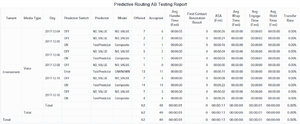enable-gpr-fcr
Section: agg-feature
Default Value: No default value
Valid Values: None. This option takes no values—its presence alone within the [agg-feature] section issues the described instructions to RAA.
Changes Take Effect: After restart of the aggregation process.
Introduced: 8.5.002.00
Modified: 8.5.011.03
Enables the aggregate table ID_FCR (AG2_ID_FCR), which provides aggregate information to support reporting on Genesys Predictive Routing (GPR).
To have RAA exclude Predictive Reporting data, remove this option from this section. The table is not presented if feature is not enabled.
enable-gpr
Section: agg-feature
Default Value: No default value
Valid Values: None. This option takes no values—its presence alone within the [agg-feature] section issues the described instructions to RAA.
Changes Take Effect: After restart of the aggregation process.
Introduced: 8.5.002.00
Enables Genesys Predictive Routing (GPR) - related columns in four aggregate tables (AG2_ID, AG2_I_AGENT, AG2_QUEUE, and AG2_QUEUE_GRP).
To have RAA exclude Predictive Reporting data from these tables, remove this option from this section. The columns are not presented if feature is not enabled.
Predictive Routing A/B Testing Report
Use the Predictive Routing A/B Testing Report to compare results for predictive models and predictors based on time-sliced A/B testing. This report includes a First Contact Resolution Rate calculation, which allows you to quickly see how often customer concerns were resolved on the first attempt, and allows you to contrast interactions that were processed when Predictive Routing was switched ON compared to when it was OFF. The report also profiles response time, engage time, wrap time, and other relevant Key Performance Indicators (KPI).
This report requires that specific RAA options be enabled: enable-gpr and enable-gpr-fcr. For more information, see the Genesys CX Insights Deployment Guide.
To get a better idea of what this report looks like, view sample output from the report: Sample_Predictive Routing_ABTesting_Report.pdf
The following tables explain the prompts, attributes, and metrics used in this report:
| Prompt | Description |
|---|---|
| Pre-set Date Filter | Choose a date from the list of preset options. This prompt overrides the Start Time and End Time values. Default: Year to Date |
| Start Date | Choose the day and time from which to begin collecting data into the report. This prompt has no effect if Pre-set Date Filter is set to anything except None. |
| End Date | Choose the day and time at which to stop collecting data into the report. |
| Media Type | Select one or more media types for which to gather data into the report. |
| Predictor | Select one or more predictors for which to gather data into the report. |
| Model | Select one or more models for which to gather data into the report. |
| Tenant | Select one or more tenants to include in the report. |
| Attribute | Description |
|---|---|
| Tenant | Enables the organization of data by tenant. |
| Media Type | Enables the organization of data by media type. |
| Day | Enables the organization of data by the day/date on which the interaction occurred. |
| Predictor Switch | Enables the organization of data by whether predictive routing is ON or OFF. |
| Predictor | Enables the organization of data by the identifier for the predictor that was used to request scoring for predictive routing. |
| Model | Enables the organization of data by the identifier for the model that was used to calculate agent scores for predictive routing. |
| Result | The result of Predictive Routing processing. If there is an error, this metric displays the error message (gpmMessage) as a value between 1 and 15.
|
| Metric | Description |
|---|---|
| Offered | The total number of customer interactions that entered or began within the contact center during the reporting interval, and were offered to a resource, excluding interactions that were abandoned within the short-abandoned threshold. |
| Accepted | The total number that customer interactions and warm consultations that were accepted, answered, or pulled by an agent, voice-treatment port, IVR port, or nonagent-associated DN (such as contact center resources that can alert) within the reporting interval. |
| Avg Handle Time (Fmt) | The average amount of time (HH:MM:SS), within the reporting interval, that this agent spent handling interactions that the agent received. Computed as handle time divided by the sum of accepted interactions and received consultations. |
| First Contact Resolution Result | First Contact Resolution (FCR) measures whether issues were resolved during the first customer attempt. A value of NO indicates that the customer raised the same issue again within 7 days.
The logic for calculating FCR is as follows:
|
| ASA (Fmt) | The average amount of time (HH:MM:SS), within the reporting interval, that it took agents to accept, answer, or pull customer interactions |
| Avg Wrap Time (Fmt) | The average amount of time (HH:MM:SS), within the reporting interval, that this agent spent on customer interactions while in ACW (Wrap) state. |
| Avg Engage Time (Fmt) | The average amount of time (HH:MM:SS), within the reporting interval, that this agent was engaged with customers on interactions. |
| Avg Hold Time (Fmt) | The average number of seconds, within the reporting interval, that customers spent on hold for interactions. This metric is attributed to the interval in which the interactions were accepted by a resource. |
| Transfer Rate | The percentage of interactions that were transferred. Calculated as the total number of transferred interactions divided by the total number of interactions. |

